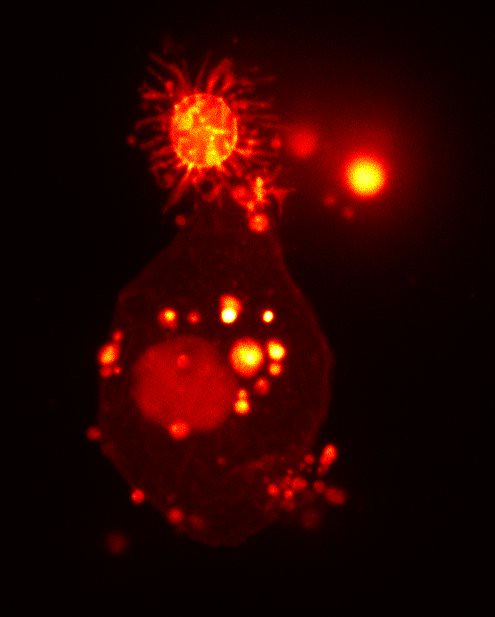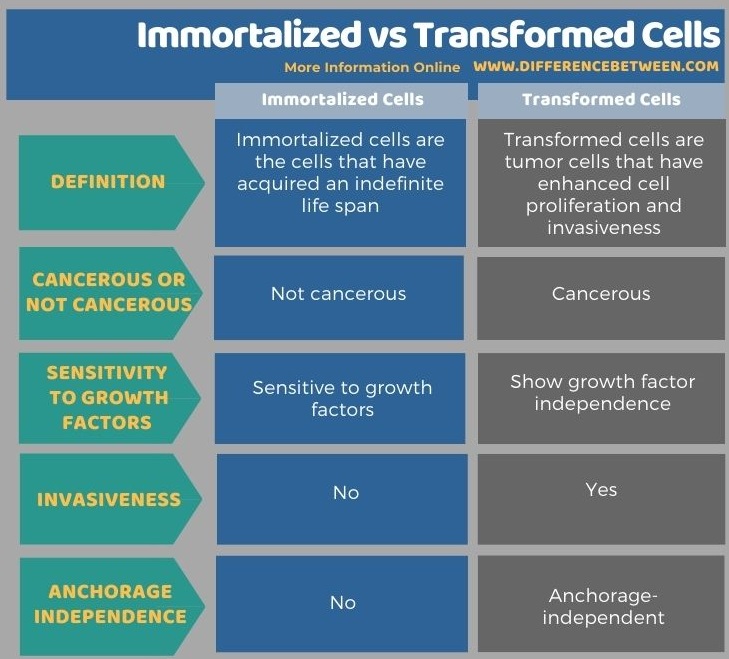The key difference between immortalized and transformed cells is that immortalized cells are not cancerous, while transformed cells are cancerous.
Transformed cells and immortalized cells are two types of cells. They divide indefinitely. Immortalized cells have an indefinite life span. Transformed cells show all the hallmarks of cancer cells. They can form large cell masses (tumours). Both immortalization and transformation are essential events of cancer formation. However, unlike immortalized cells, transformed cells show enhanced cell proliferation and invasiveness.
CONTENTS
1. Overview and Key Difference
2. What are Immortalized Cells
3. What are Transformed Cells
4. Similarities Between Immortalized and Transformed Cells
5. Side by Side Comparison – Immortalized vs Transformed Cells in Tabular Form
6. Summary
What are Immortalized Cells?
Immortalized cells are the cells that have the ability to divide indefinitely. In other words, immortalized cells are cells that have an infinite life span. Generally, normal cells have a finite life span, but immortalized cells have an infinite life span. They have the ability to produce continuous cell lines. Therefore, immortalized cells have evaded senescence. Most importantly, it is strongly believed that immortalization takes place when some of the cell cycle regulatory genes are inactivated. Immortalized cells have undergone sufficient mutations to have an infinite life span. However, unlike transformed cells, immortalized cells are not cancerous. They show dependence on growth factors and are sensitive to growth inhibitors as well.

Figure 01: Immortalized Cells
Cells can acquire immortalization spontaneously; it can also be established in the lab. Immortalized cells show many advantages. Generally, they are used as standard cell lines in many labs. Immortalized cells are homogenous and genetically identical cell populations. Hence, they generate reproducible results. They are also easy to culture in labs. Moreover, it is not necessary to extract them from a living animal. Immortalized cell lines grow quickly and can express a gene of interest continuously. Hence, they can be used to extract large amounts of proteins for biochemical assays. HeLa cells are a type of immortalized cells and they are widely used to test pharmacological agents and to develop vaccines. Furthermore, immortalized cells can be utilized for monoclonal antibodies. But, the major disadvantage is that immortalized cells cannot be considered normal cells.
What are Transformed Cells?
Transformation is a process central to the formation of cancerous cells. Transformation allows cells to become uncoupled from the regulatory mechanisms. It also allows cells to grow rapidly and invasively, showing indefinite proliferation. Transformed cells have all the characteristics of cancerous cells. Therefore, they are cancerous cells. They can proliferate indefinitely, forming large cell masses, especially tumours. They show independence from growth factors.

Figure 02: Transformed Cells
Moreover, transformed cells do not respond to growth inhibitors. They can evade apoptosis. Furthermore, they do not enter the senescence stage. Most importantly, they can promote angiogenesis. They are also invasive cells. Transformed cells show anchorage independence, and the cells grow in a disorganized fashion. Transformed cells are also characterized by loss of contact inhibition.
What are the Similarities Between Immortalized and Transformed Cells?
- Both immortalized and transformed cells do not show senescence.
- They can divide indefinitely.
- Immortalization and transformation are two events of oncogenesis.
- Both transformation and immortalization can occur spontaneously or due to viral infection.
What is the Difference Between Immortalized and Transformed Cells?
Immortalized cells divide indefinitely, and they have an indefinite life span. Transformed cells have enhanced cell proliferation ability and invasiveness. Hence, transformed cells are cancerous cells, while immortalized cells are not cancerous cells. So, this is the key difference between immortalized and transformed cells. Moreover, immortalized cells show dependence on growth factors, and they are sensitive to growth inhibitors. On the other hand, transformed cells show growth factor independency, and they show no response to growth inhibitors. Thus, this is another significant difference between immortalized and transformed cells.
The below infographic summarizes the differences between immortalized and transformed cells in tabular form.

Summary – Immortalized vs Transformed Cells
Immortalized cells can divide indefinitely. They have an indefinite life span. But, immortalized cells are not cancerous. Transformed cells are cancerous cells, and they show enhanced cell proliferation ability and invasiveness. Moreover, transformed cells show anchorage independence and contact inhibition. Thus, this is the summary of the difference between immortalized and transformed cells.
Reference:
1. “Cell Transformation and Characteristics of Transformed Cells.” Biology Discussion, 16 Oct. 2015, Available here.
2. “Cancer Genetics.” CuboCube, Available here.
Image Courtesy:
1. By TenOfAllTrades at English Wikipedia – Own work (Public Domain) via Commons Wikimedia
2. “Transformed Alien Cell” by Robert Bill, University of Zurich” By SNSF Scientific Image Competition (CC BY-NC-ND 2.0) via Flickr
ncG1vNJzZmivp6x7pbXFn5yrnZ6YsqOx07CcnqZemLyue8OinZ%2Bdopq7pLGMm5ytr5Wau261zKamq6yRoba7scNmmKecXam%2ForrSn6arpZWZeqSxy6WqaA%3D%3D